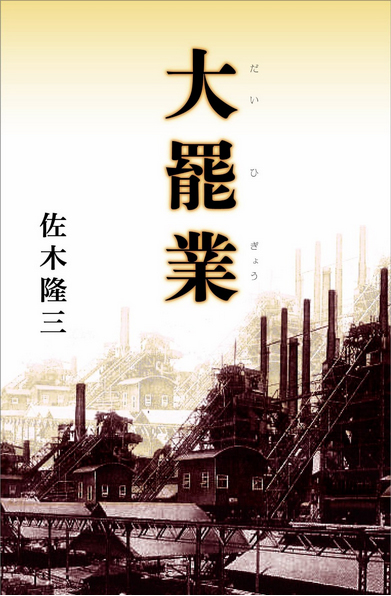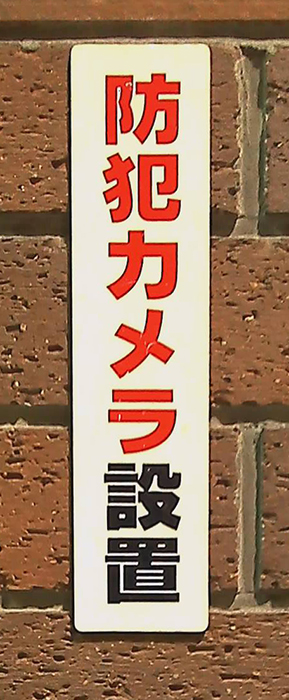122. The "Net" Radical: 罒 and 网
Graphically, the "net" radical is quite simple. After all, the five-stroke 罒 consists of just three connected boxes, as in these examples:
置 (545: to place, put, leave behind; establish; alternation suffix)
罰 (1709: punishment, penalty)
My yoga studio has three instances of radical 122 near the ceiling, along with one prominent example of radical 30 (口), the "mouth" radical! How can anyone concentrate on yoga poses with so many radicals hanging overhead?!
Photo Credit: Eve Kushner
A Dead Ringer for Radical 109
Despite this graphic simplicity, 罒 does present some complications, primarily because it looks exactly like the variant of radical 109, the "eye" radical:
parent shape of 109: 目
variant shape of 109: 罒
Whenever the variant of 109 appears in Joyo kanji (always as a mere component, rather than as an on-duty radical), there's no immediate way of knowing that the 罒 involves an eye. In 夢 (1844: dream; vision), for example, I would have guessed that that shape represented a net enabling one to catch dreams. The eye-related 罒 also lies in the middle of 蔑 (2107: contempt, disdain, scorning; despising; ignoring), whose meanings are quite similar to that of this kanji:
罵 (2092: abuse)
However, there's a net atop 2092, not an eye. Go figure!
No harm will come to you if you mix up these two radicals! However, it's worth remembering that there's a distinction to be drawn.
Photo Credit: Eve Kushner
I love seeing a huge rendering of our radical in a sign from Sado Island (northwest of Honshu). The sign puts the spotlight on this kanji:
罪 (686: crime; sin)
Because the character functions as a singleton here (rather than being part of a compound), we read it as つみ (sin).
I've omitted the lower part of the sign because it presents religious views that turn my stomach. If you're curious, you can find the full text and explanation in JOKIA 324 on 神.
What's the Parent and What's the Variant?
Here's a second bit of trickiness involving the "net" radical. Sources treat 网 as the parent, 罒 as the variant. The rationale must be that 网 was the original shape. But I think that's silly because we'll never encounter 网 in a Joyo character, so it does us no good to think of it as the shape of this radical. For that reason, I'll reverse the labels, treating 罒 as the parent and 网 as the variant.
I did the same thing with radical 140, the "grass" radical, presenting 艹 as the parent and 艸 as its variant. And I did so for the same reason; when you're trying to isolate the radical in a character, it serves no purpose to look for a 艸 shape that you won't find.

Our radical takes center stage on the cover of a book, appearing in this kanji:
罷 (1732: to dismiss, fire; quit, stop; emphatic verbal prefix)
That character lies at the heart of the title:
「大罷業」
The Big Walkout
大- (だい-: big);
罷業 (ひぎょう: strike; walkout)
The book is about a big strike in 1920 against working conditions at the Yahata Steel Mill in Fukuoka Prefecture on Kyushu.
Names of Radical 122
As you know, the English name of radical 122 is simply "net," but the Japanese nomenclature presents yet another bit of trickiness. I found all these possibilities in Nelson:
1. あみがしら (網頭: "net crown")
2. あみめ (網目: "net shaped like the eye kanji")
3. よこめ (横目: "sideways eye")
4. めがしら (目頭: "eye crown")
Let's go over each one:
1. あみがしら (網頭 or 罔頭: "net crown")
My proofreader is most familiar with this radical name and says that all his sources present it, sometimes along with others. The kanji 網 (1855: あみ) means "net" but doesn't include our radical! You may be wondering about the non-Joyo 罔 in the alternate rendering. Our variant shape, 网, is the original form of 罔, which is in turn the original shape of 網. Meanwhile, 頭 (かしら, voiced here as がしら) refers to a radical atop a kanji. For more on this, see Radical Terms and look at the section "Radical Positions" (position 3) and "Radical Names" (again, position 3).
2. あみめ (網目: "net shaped like 目 (め)")
This name seems valid to me, as it makes a connection between the two types of 罒. However, the succinct symbolism doesn't indicate that the "net" radical is shaped only like the sideways 目. The next option takes care of that.
3. よこめ (横目: "sideways eye")
Two of my proofreader's sources list this as a possible name for radical 122. Now we have an explicit reference to the sideways orientation, but the name is murky in terms of the relationships between radicals 109 and 122.
4. めがしら (目頭: "eye crown")
The murkiness continues.
Let's use あみがしら (網頭: "net crown")! That says enough!

Photo Credit: Lutlam
Here's a nonreligious example of 罪 (686: crime; sin). Henshall tells us that the etymology of this kanji is somewhat obscure but that the radical contributes connotations of "catching."
The text is as follows:
万引き警戒中
On the lookout for shoplifters
万引き* (まんびき: shoplifter, shoplifting); 警戒中 (けいかいちゅう: on the lookout)
万引きは犯罪です
Shoplifting is a crime
犯罪 (はんざい: crime)
The Net Meaning
It's surprising to find a shape meaning "net" in multiple kanji. Let's examine the role of 罒 in three of the seven Joyo kanji with this on-duty radical:
署 (897: government office; station to serve the public; signature)
The character combines "net" and "person" (者). This 者 also acts phonetically to express "to put," says Henshall, noting that 署 originally referred to people ordered to put a net in place during a hunt. That meaning led to "employed person," then to "official," and finally to "place where officials work." It's possible that "signature" is a borrowed meaning, but it could be associated with "government office."
罷 (1732: to dismiss, fire; quit, stop; emphatic verbal prefix)
The radical has to do with "catching a powerful person in a net and rendering that person unable to move," according to Kanjigen. Henshall says in his newer edition that 罷 combines “net” (罒) with “ability” (能). The latter shape may act phonetically here to express “withdraw,” originally making 罷 mean “remove a net.” Alternatively, the 能 might convey “withdraw, abandon,” yielding the overall sense “abandon net previously set up.” Those are the views of two experts. A third sees the 能 as showing a wild animal caught in a net, causing 罷 to mean “tire” and “give up,” but Henshall points out the illogic in that idea. He also notes that 能 was the original way of writing “bear,” now represented by 熊.
羅 (1887: net; fabric; in a row; ラ sound)
Henshall says in his newer edition that an old form of 羅 combined "net" (罒) with "bird" (隹), collectively yielding "catch bird in net." Only at the seal stage did "thread" (糸) come into the picture.
Thus, in all three cases the net is a device for catching animals. I suppose this makes sense; the characters emerged just a bit before the Net, so that meaning couldn't have factored into the etymologies!

Photo Credit: Lutlam
Our radical appears in the last word in this sign:
防犯カメラ設置
Crime-prevention cameras installed
防犯 (ぼうはん: crime prevention); 設置 (せっち: installation)
Here's what the final kanji means:
置 (545: to place, put, leave behind; establish; alternation suffix)
Henshall says that this character combines "net" (罒) with "direct" (直). The 直 acts phonetically to express "to erect, set up," in addition to "directly." Jointly, these shapes produce "to set up a net directly (in something's path)," later leading to the meaning "to put in place."
In the context of crime prevention, the idea of our radical as a net gives new meaning to the idea of "to catch a thief." One imagines a net falling over a thief.
Photo Credit: Eve Kushner
This sign in the 麻布 (あざぶ) section of Tokyo is for a 税務署 (ぜいむしょ: tax office). Bureaucrats working at this government office collect taxes and seize the properties of tax evaders.
